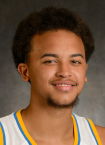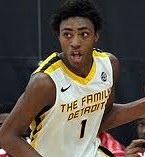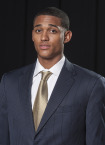CHICAGO — No, Andrew Wiggins. No Jabari Parker. No Joel Embiid.
Since most of the projected upper-echelon 2014 NBA Draft Lottery picks chose not to participate in drills at the combine, the door was open for other players to come in and catch the attention of GMs and scouts in attendance, who were, of course, out in abundance doing their due diligence and networking with just over a month until draft day.
While there were many prospects who stood out at the combine, for reasons both good and bad, we chose to identify five players on the rise after the 2014 NBA Draft combine this past Thursday and Friday at the Quest Multisport on the west side of Chicago.
Keep in mind, players can improve their stock by sitting out, too, as noted in the rite-up of Elfrid Payton below.
 Zach LaVine, 6′-4 1/2″, 181 lbs, Freshman, UCLA
Zach LaVine, 6′-4 1/2″, 181 lbs, Freshman, UCLA
LaVine is a perfect example of a prospect whom you need to see in person and speak with to truly appreciate. His athleticism is sneaky-smooth (33.5″ standing vertical) and his movements on the court seem effortless at times as a result. There were multiple occasions when LaVine threw down vicious dunks after the play had ended, and clearly he’d caught the attention of the room.
However, it wasn’t so much his dunks as it was the fierce attitude/work ethic and smooth nature of his jump shot that separated LaVine from some of his peers.
LaVine is one of the players who elected to participate at the combine to boost his draft stock, despite likely being a first-round pick anyway.
“I’m very confident about my talents,” said LaVine. “I’m a competitor and I’m not scared of competition so it’s not something I was nervous about.”
The reason he wasn’t scared is this type of setting is complementary to LaVine’s skill set.
LaVine’s jumper, in both catch-and-shoot and off-the-dribble situations, proved to be of the smoothest in the gym during the combine. There is a catch-22, though. LaVine sports an awkward release, which clearly shows he utilizes his left hand. If I’m a team that might draft him, I’m looking at this optimistically: LaVine is already a decent shooter. If you combine his hard working nature with the proper coaching, he can fully remove his left hand from the release of his shot, thus potentially making him a much more consistent shooter in time.
While he struggled to stay involved this season playing on a talented UCLA team, LaVine will have to improve his assertiveness and basketball IQ to become the player he thinks he can become.
“Growing up I was a huge Kobe fan,” said LaVine. “He was my idol. His competitive spirit — people might call him cocky or arrogant — but I feel like he’s got a lot of confidence in his game and he’s put a lot of hard work in and he’s a killer. The players who I try to model my game after are Russell Westbrook with the athleticism, Stephen Curry with his dribbling and ability to shoot off the dribble, and Jamal Crawford, who can get his shot off on anyone.”
The ceiling is high for LaVine. He’s cemented his status as a first round pick. Only time will tell how high much production he squeezes out of his potential.
Kyle Anderson, 6′ 7 1/2″, 230 lbs, Sophomore, UCLA
I’ve been around Anderson enough throughout his career that I know a few things about him: He reads and processes the game on a level few players his age do, and he’s willing to put in the work to get the most out of his potential.
There was a time when it was seemingly fashionable to doubt Anderson’s abilities, as analysts questioned whether or not he would be able to keep up with the speed of the college game and, beyond that, the speed of the NBA.
I spoke with Anderson’s godfather, a brilliant basketball mind, about this situation.
“Kyle is always going to find a way to win,” he told me.
Without the comfort of a pure projected position, the team who drafts Anderson will rely on the fact that he is an excellent option to stretch the floor as a big playmaker who will make good reads most of the time.
“They told me what they see me playing in their offense and a lot of the NBA game is interchangeable between the 1, 2 and 3 position,” said Anderson, responding to the million-dollar question regarding what position he will actually play in the NBA.
“I think my best attribute is passing the ball,” continued Anderson. “I make my teammates better and put them in the best position to score.”
Indeed, Anderson has a keen, almost second nature, ability to get the ball to his teammates, “On time, on target,” as the saying about being a playmaker goes.
Lateral quickness will be an issue for Anderson defensively, at times, but his high basketball IQ and 7’2.5″ wingspan will help to compensate for this weakness, especially in time.
Elfrid Payton, 6’2.5″, 185.4, Junior, Louisiana-Lafayette

In a draft that doesn’t have many pure playmakers, Payton might be the beneficiary. Sitting out this week was a win in its own right because the point guard crop at hand was not the most impressive.
A sneaky quick athlete, Payton excels at getting into seams of the defense and finishing with a variety of scoop shots with either hand and is a capable finisher above the rim.
That being said, considering his crafty ball-handling skills and almost effortless ability to penetrate into the lane, he has much work to improve his decision making once he gets there. His 5.8-to3.5 assist-to-turnover ratio will need to improve in order to excel in the NBA, and with cleaner spacing and more scoring options, you have to think he’d be a better decision maker.
Remember, Payton was on an average team in the Sun Belt last season.
“I come from a small school and I’ve always had a chip on my shoulder,” he said. “That just makes it even bigger.”
Thanks to his size and style of play, Payton has been drawing Rajon Rondo comparisons.
“The way he plays defense,” said Payton, who averaged 2.3 steals per game as a junior. “He gets his hands on a lot of balls. He gets his teammates involved and makes them better. That’s what I really like about him.”
Though Payton must improve his jump shot if he’s going to reach his potential, he’s a clear leader who will run the team.
“I think the best point guard in the draft,” Payton said. “A leader. Somebody who is going to try to bring a winning culture to the team. Bring somebody in to make everybody better.”
 James Young, 6’5.25, 213.3, Freshman, Kentucky
James Young, 6’5.25, 213.3, Freshman, Kentucky
Young didn’t participate in drills at the combine, but that didn’t stop him from shooting around with the other wing players as he waited to be tested on Friday.
He clearly has a natural release on his jump shot, which should continue to gain range as he adds strength and, hopefully, better habits. Watching him shoot, it was abundantly clear that he rotates his body to the right as he extends upward on his shot, which will undoubtedly affect the consistency of his jumper.
That being said, Young has excellent size and athleticism — he’s one of those guys who appears bigger than he measures — to play the 2-guard position, and this past season at Kentucky he proved that he can implement them in games all at once, though he certainly could’ve been more consistent.
“Him off the dribble, his versatility,” said Julius Randle, a surefire lottery pick and former teammate of Young’s this past season at Kentucky. “His being able to do things with the ball, without the ball. He’s a very good athlete. Him being able to show all those things. He’s an extremely good athlete. Just as far as how fast he is and how he can jump? He’s a really good athlete.”
With even more space and even better playmakers in the NBA, I expect Young to excel as a scorer both slashing to the rim and from the perimeter. If he has the heart and basketball IQ to continue to learn to play solid defense, he could become a very valuable two-way player.
Jordan Clarkson, 6’3 1/4″, 186 lbs, Junior, Missouri

Clarkson shot just 32.75% from downtown in his two years at Missouri, but at the Combine his jump shot was one of the smoothest in the gym.
“Drew Hanlen (Pure Sweat basketball) reconstructed my shot. I was shooting a little too low under my face before I finished college. We worked on making my release a little higher, getting my elbow above my eyebrows, finishing with my fingers in the basket and keeping the release high when you shoot.”
Clarkson’s recent work paid off in spot-up shooting drills at the combine, as he shot at a 70 percent clip with solid mechanics. Moreover, he was above 80 percent at the charity stripe in college, which means the potential to become a better shooter in catch and shoot situations was dormant.
Combine his improved shooting stroke with above average playmaking ability and athleticism (33″ standing vertical) and Clarkson could be a second-round steal.
(RELATED: NBA DRAFT PREVIEW: WHO IS THE NEXT DAMIAN LILLARD)
(RELATED: JOE KOTOCH’S MOCK DRAFT 2.0: COMING OUT OF THE COMBINE)
Jeremy Bauman is a shooting coach and aspiring front office professional who writes columns for SheridanHoops.com. At night time he can be found at STATS LLC / SportVU, the NBA’s emerging game-tracking software, as an Overnight Data Analyst. Follow him on Twitter @JB_For_3_.